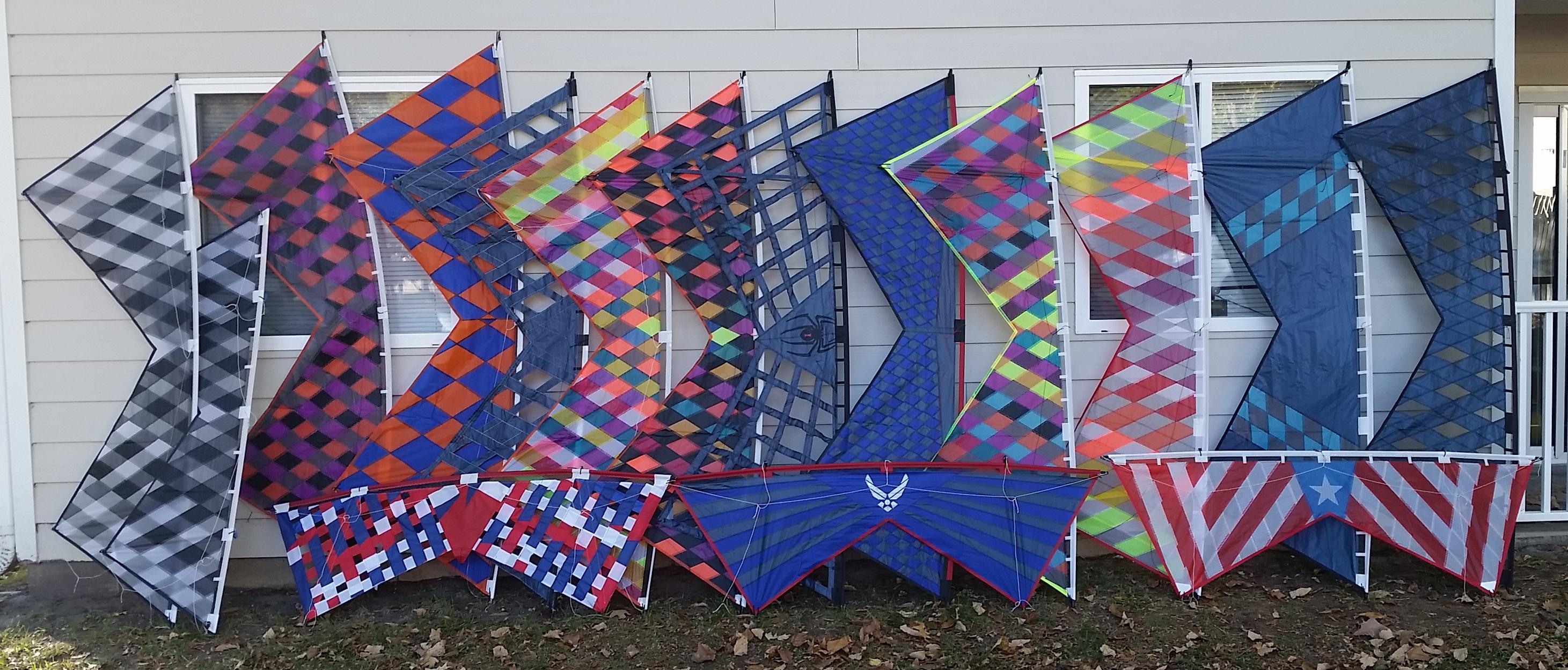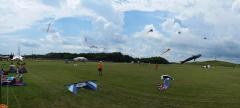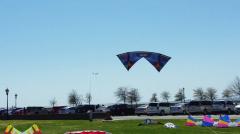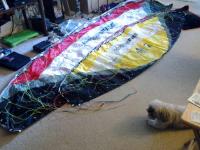-
Posts
3,015 -
Joined
-
Last visited
-
Days Won
332
Content Type
Profiles
Forums
Gallery
Downloads
KL Shop
Blogs
Articles
Everything posted by riffclown
-
I can tell we haven't met.. I'm closer to the carnival sideshow.... You should see me with a deck of cards.. I'd love to fly with you sometime..
-
If it works, then why not???
-
I did make my first one which is a rollup but recently received a Prism Bag which is also nice. It gave me a few ideas I have to incorporate into my home made bag. now..I do like my fold up wagon though.. I'm currently considering a Hard Golf Club Travel Case to modify and protect my kites.. Has the extra benefit of being sand and water "resistant" since it will be standing up instead of laying down. Think Umbrella stand type scenario with a lid.
-
Another viable option is to only sleeve one end of the lines. All adjustments are made from the sleeved end. The unsleeved end left in its knotted configuration.. You then have the benefits of both configurations.. Sleeker lines at the kite, easier adjustments at the sleeved handle end....
-
He doesn't know everything .. Granted.. He Knows more than me and is willing to share .. Big Plus That's good enough for me.. We're actually in agreement, if you ever stop learning, there's no reason to teach or share.. Someone that knows EVERYTHING, actually knows nothing..As advanced as the top fliers are, I'd almost guarantee they learn new things regularly. There's no other way to stay in the top of the field without doing so. @Paul LaMasters Thank you so much for the pointers at ODSKC 16.
-
Reminds me of the old joke. "He knows everything that can be known. I know the rest." He's definitely a resource you can learn from..and doesn't mind sharing the knowledge.
-
I think you'd have to add material as well to provide the strength and "stretch" resistance. If you're adding those things, you're also adding additional weight. Not necessarily a bad thing.. EVERYTHING in kiting is a matter of trade offs. Strength vs Weight. Design vs. Architecture, Materials vs. Cost. The key is finding the balance that meets your needs for any given set of conditions.. Also, the simple thread seam wouldn't provide the channeling of airflow across the sail itself. Those small areas of slight turbulent flow and air resistance on an otherwise laminar like flow structure provides the feel or touch that is so coveted. If you look at the B-Series sail design you can almost see the channeling of the actual air flow. When you get into Vented and Mesh Kites, it's also interesting to note if you look a something like a Shook Mesh, you can see the same channeling with the breaks between the sails providing an open air relief for the strip immediately preceding it.. That's one reason I prefer a mesh over a vented. You get a highly reduced pull without sacrificing the overall balance of the sail surface. The additional break points actually increase the feel of the kite over a normal vent pattern. Sorry, the engineer in me tries to get out sometimes. FWIW, I enjoy flying the one piece sails more than the SLE I have. I've only recently gotten my first B Series and I'm really looking forward to flying it.
-
From the album: riffclown's kite album
Old Glory SUL in Flight at the Wright Kite Festival in Kill Devil Hills, Kitty Hawk NC. -
But by keeping the price points high, they've all but invited the very competition they've fought all these years. IMO, they've maximized their profit in the short term but they've done it at the expense of the brand itself.
-
I almost went to Dorey Today for the RAF First Sunday Fly but decided to stay local instead.. Same "non-winds" down here on the peninsula. I Don't have a Zen but have a few sails for light conditions.. Still working through some of the advice that Paul sent my way that day as well..
-
Sounds like you got some excellent customer service and advice.. There are some very good quadline fliers in that area.. Find a proficient flier to fly with and learn from.. There's no greater teacher than in person experience..
-
Sent you a vid link of some very low wind flying at the ODSKC.
-
Lesson from @Paul LaMasters it sounds like..A True light wind specialist..
-
I have the two Trifinity (RWB and Rainbow) and also recently received the Skulls kite. The printed Revs open up the possibility for lots of custom printed sails without a "retooling" or re-patterning cost BUT at a price point higher than the current offerings ($350.00 for the Printed Kite Only vs. $265 for the 1.5 or $330 RTF) and even the NYM Sail only price of $325-ish, it almost feels like the Kite version of Stamp Collecting.. (Stated Prices based on averages between several dealers as not all items available all places) I'd think the Dye Sub kites would be much cheaper to produce than a sewn sail like the JB, NYM, SLE or 1.5 series..Especially with the money they obviously saved with the new frames included with the kites.
-
Is it one of the newer Green Trimmed Rods? They've had issues with being prone to breaking. If one of those and the kite is relatively new, I'd say contact Revolution concerning the issue. There's a good chance they might replace it for you.. There's a topic in Quad Heads concerning the rods themselves.. http://kitelife.com/forum/topic/7033-rods-the-difference/ And if the impact with the ground was the type that's your fault and would have broken anything, (it happens to all of us at some point) then there are suitable replacements available from many vendors. I tend to like the Sky Sharks. Both "Into The Wind" and The Kite Shoppe have suitable replacements available for purchase.. As for avoiding the impacts with the ground, first make sure your flying lines are equalized. The best advice kite-wise is fly in lighter conditions initially and really get to know the flying aspects of your kite. Resist the temptation to start tweaking your setup until you are familiar with the stock setup. As you progress in skill your comfort level will increase along with your confidence level. Keep your kite high off the ground until you are very familiar with the way it flies.You can then start tweaking it to suit your flying preferences and style..
-
Extremely well stated..
-
Dye Sublimation one piece sails the wave of the future for Rev?.. Don't get me wrong, I have 2 Trifinity Kites and I like them. In normal to light conditions, one of those is the first Rev I unpack. I usually start on 30ft lines. In retrospect a new JB Series comes with 2 Frames, more labor intensive sail, Vented options and seems an overall better value. Market Price has it near the same price point. For the Dye Sub,as with any printed material. the design can be changed on a computer and "ta-da" --> new kite. The Dye Subs are also marketing around the same "Kite Only" market price point as the NYM which also has Vent options and typically a second frame.. Is the printed sail "and collecting them" to be Revolution's new prime offering?? What are your thoughts on a one piece sail that is simply set apart from others by the print?
-
Nice example of a LEI. Great for Water based kite sports
-
From the album: riffclown's kite album
Demo field and Memorial. -
From the album: riffclown's kite album
Demo field -
From the album: riffclown's kite album
ODSKC 2016 Conditions were extemely light that day. -
From the album: riffclown's kite album
Flying the Rainbow Trifinity at Ft Monroe -
From the album: riffclown's kite album
LONG LINES. Photo courtesy of Aaron Firth. Park Ranger Fort Monroe National Monument. -
First WELCOME to the wonderful world of powerkiting. If your question is "What kite should I buy?" The answer is "it depends." What you will be asked by most of us is, Where are you? Where do you fly? (or want to) What kiting experience do you already have? What aspect of powerkiting are you interested in? (Buggying, Landboarding, Snow Kiting Kite Surfing, Jumping, etc..) What are your local winds like? (Averages, gustiness etc.) How much do you weigh? (Not trying to be personal, Bigger people are less likely to be overpowered by marginally bigger kites and most of us want to start you on a kite that will teach you without hurting you.) What kind of budget are you looking at? (just to narrow choices) On average, the most popular answer if you are looking to START in the sports of power kiting is a 2-3M Fixed Bridle Kite. It can be flown in low winds as a static kite to learn on and will most likely be a kite you keep as your moderate to high wind kite as you progress in the sport.. If you are a stunt flyer, let us know up front because you might not be happy with a 3M kite if you want to do spins and dive stops. That's where kites like the Spiderkite Smithi or my symphony 2.2.4 Conversion most often enter into the conversation. If you want to jump, STOP, wait a sec and listen to the wisdom of the advanced kiters. To safely jump you'll want a kite at least 5M square with some float so you can land safely. DO NOT be tempted to just start with a 5M kite and think you can jump.. You will get yourself hurt or worse. The advice here is still a 3M or so kite and once you know EVERY characteristic of how the wind affects you holding the handles, then move up and seek the advice/counsel of our experience Kite jumpers. (Skydiving reasoning seems applicable here. It doesn't take a parachute to sky dive.. It takes a parachute to sky dive twice. With one recent exception..) (Disclaimer: These lists are not by any means comprehensive. They are merely first-hand examples by me and some very experienced fellow power kiters. Sport Kite Most often these are 2 line foils and are sized by span (2.2 being 2.2 meters wide) This is the kite you find in stores very often and is a great first exposure to foils and a great place to start if you've not flown a multiline kite before. Examples of Sport Foils are: *HQ Symphony (Multiple sizes) *Prism Snapshot (Multiple Sizes) ** the 2.5 size is already bridled for four lines Trainers These are often Sports kites geared towards learning to fly on a bar. Sometimes they are sized like sport kites others are sized in Square meters like Power Kites. Examples of Trainers are: *HQ Hydra *HQ Kites Rush Pro *Ozone Imp Trainer *Peter Lynn Impulse TR Fixed Bridle Power Foils These are 4 line kites measured in Square Meters and are geared towards pulling and/or lifting. These are powerful kites and the dangers here are complicated by new fliers assuming the sizing is consistent with the Sport variety. It is not!! A small power foil can really do a lot of damage to you if you aren't ready for the big difference in pull. These kites are most often used for buggying but are not limited to that aspect of the sport. Examples of Fixed Bridle Foils are: *HQ Beamer *HQ Toxic *Peter Lynn Hornet *Peter Lynn Reactor *Peter Lynn Voltage *Skydog Powerfoil *Buster Soulfly *Ozone Flow *Ozone Octane *Flexifoil Bullet *Flexifoil Rage Depower Kites These are multiline kites most often used for Board Sports, WaterSports and Buggying. They are able to be depowered (or sheeted) and are flown with a control bar. A fixed Bridle kite on a bar does not make it a Depower kite) Depowers are generally larger than Fixed bridles for the same conditions and tend to be able to ride out gusts more gracefully. Depowers also tend to be more expensive due to materials and control mechanisms. They also tend to have a wider wind range for a given size than their FB counterparts so a single DP kite may cover wind ranges you'd need multiple FB kites to navigate comfortably. Examples of Depower kites are: *HQ Apex *HQ Montana *HQ Matrixx *Ozone Access *Ozone summit *Ozone Frenzy a few other notes Another aspect of kite design is open or closed cell and LEI (leading edge inflatable) Open cell kites are typically limited to land activites and are inflated by the wind. Land them in water and they stay in the water until you rescue them.. Closed cell kites are either inflated via pump or inflated by the wind while flying but have valves or baffles to prevent them from deflating. If landed on the water, they simply float until relaunched. LEIs have the similar water launch capabilities as closed cell foils but are inflated with a pump and are generally single skin designs for simplicity. As for the bottom line, On average, the most popular answer if you are looking to START in the sports of power kiting is a 2-3M Fixed Bridle Kite. It can be flown in low winds as a static kite to learn on and will most likely be a kite you keep as your moderate to high wind kite as you progress in the sport.. The suggested starting size can go up or down based upon your weight , experience and local flying conditions.. Wear a helmet and above all BE SAFE!!.. NPW Section by ssayre NPW or Nasa ParaWing Kites The Nasa ParaWing was invented by Francis Rogallo in 1961 as part of research as a means of space capsule recovery. Since then it has been modified into several variations of steerable kites. They are a fixed bridle kite that are flown using 2 lines or 4 lines. The exception being the Nasa Star which is flown as a 2 line kite but utilizes a 3rd line that will partially or totally collapse the nose to reduce or kill power when used with an adapted 3 line bar. This style of kite has some distinct advantages and disadvantages over traditional foil power kites. The advantages: They are single skin which allows them to fly in light wind and maintain their shape during lulls in the wind. They sit deep in the window providing tractor like pulling power to keep you moving. They fly very well on any length of line allowing them to be used for "streetkiting" in confined areas. They are very quick turning when flown in either 2 line or 4 line configuration allowing you to place the kite where you need it in the window quickly. They are comparatively inexpensive to their fixed bridle foil counter parts. They are a solid choice and provide reliable power for inland fliers looking to get in motion. The disadvantages: They have a smaller window which does a couple things. Their upwind ability is less than traditional fixed bridle foils and they are not as fast flying through the window. This coupled with smaller window makes them a poor choice for someone looking for a kite that is exciting and fun for static flying. They generate low lift which is either good or bad depending on what you want to do. If not kept moving in light wind they can have a tendency to fly backwards. They are not readily available commercially and must be purchased from a kite maker or purchased from Born-Kite, the only known manufacturer in Germany. Examples of sizing below.. Symphony 2.2 on a 2 Meter Crossfire 2. Another Symphony 2.2 on a 4M Crossfire II and then finally a direct comparison for the 2 & 4M Crossfires.








